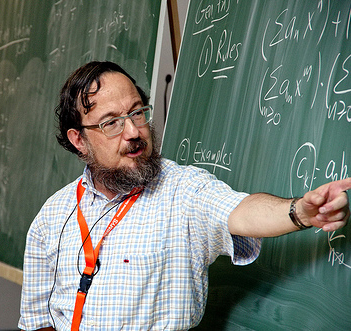Introduction
Four mathematicians, Michael Griffin of Brigham Young University, Ken Ono of Emory University (now at University of Virginia), Larry Rolen of Vanderbilt University and Don Zagier of the Max Planck Institute, have proven a significant result that is thought to be on the roadmap to a proof of the most celebrated of unsolved mathematical conjecture, namely the Riemann hypothesis. First, here is some background:
The Riemann hypothesis
The Riemann hypothesis was first posed by the German mathematician Georg Friedrich Bernhard Riemann in 1859, in a paper where he observed that questions regarding the distribution of prime numbers were closely tied to a conjecture regarding the behavior of the “zeta function,” namely the beguilingly simple expression $$\zeta(s) \; = \; \sum_{n=1}^\infty \frac{1}{n^s} \; = \; \frac{1}{1^s} + \frac{1}{2^s} + \frac{1}{3^s} + \cdots$$ Leonhard Euler had previously considered this series in the special case $s = 2$, in what was known as the Basel problem, namely to find an analytic expression for the sum $$\sum_{n=1}^\infty \frac{1}{n^2} \; = \; \frac{1}{1^2} + \frac{1}{2^2} + \frac{1}{3^2} \cdots \; = \; 1.6449340668482264365\ldots$$ Euler discovered, and then proved, that in fact this sum, which is $\zeta(2)$, is none other than $\pi^2/6$. Similarly, $\zeta(4) = \pi^4/90$, $\zeta(6) = \pi^6/945$, and similar results for all positive even integer arguments. Euler subsequently proved that $$\zeta(s) \; = \; \prod_{p \; {\rm prime}} \frac{1}{1 – p^{-s}} \; = \; \frac{1}{1 – 2^{-s}} \cdot \frac{1}{1 – 3^{-s}} \cdot \frac{1}{1 – 5^{-s}} \cdot \frac{1}{1 – 7^{-s}} \cdots,$$ which clearly indicates an intimate relationship between the zeta function and prime numbers. Riemann examined the zeta function not just for real $s$, but also for the complex case. The zeta function, as defined in the first formula above, only converges for $s$ with real part greater than one. But one can fairly easily show that $$\left(1 – \frac{1}{2^{s-1}}\right) \zeta(s) \; = \; \sum_{n=1}^\infty \frac{(-1)^{n+1}}{n^s} \; = \; \frac{1}{1^s} – \frac{1}{2^s} + \frac{1}{3^s} – \cdots,$$ which converges whenever $s$ has positive real part, and that $$\zeta(s) = 2^s \pi^{s-1} \sin\left(\frac{\pi s}{2}\right) \Gamma(1 – s) \zeta(1 – s),$$ which permits one to define the function whenever the argument has a non-positive real part.
The zeta function has a simple pole singularity at $s = 1$, and clearly $\zeta(s) = 0$ for negative even integers, since $\sin (\pi s / 2) = 0$ for such values (these are known as the “trivial” zeroes). But it has an infinite sequence of more “interesting” zeroes, the first five of which are shown here:
| Index | Real part | Imaginary part |
| 1 | 0.5 | 14.134725141734693790… |
| 2 | 0.5 | 21.022039638771554992… |
| 3 | 0.5 | 25.010857580145688763… |
| 4 | 0.5 | 30.424876125859513210… |
| 5 | 0.5 | 32.935061587739189691… |
Note that the real part of these zeroes is always 1/2. Riemann’s famous hypothesis is that all nontrivial zeroes of the zeta function lie along the line ${\rm Re}(z) = 1/2$. The Riemann hypothesis is widely regarded as the most significant outstanding unsolved problem in mathematics. For instance, the Clay Mathematics Institute lists the Riemann hypothesis as one of its “millennium problems,” the solution to which would qualify for an award of one million U.S. dollars. For some additional background on the Riemann hypothesis, see this article written by Peter Sarnak for the Clay Institute.
Consequences of the Riemann hypothesis
If the Riemann hypothesis is true, many important results would hold. Here are just two:
- The Mobius function: Define the Mobius function of a positive integer $n$ as: $1$ if $n$ is a square-free positive integer with an even number of prime factors; $-1$ if $n$ is a square-free positive integer with an odd number of prime factors; and $0$ if $n$ has a squared prime factor. Then the statement that $$\frac{1}{\zeta(s)} \; = \; \sum_{n=1}^\infty \frac{\mu(n)}{n^s}$$ is valid for every s with ${\rm Re}(s) \gt 1/2$, with the sum converging, is equivalent to the Riemann hypothesis.
- The prime-counting function: For real $x \gt 0$, let $\pi(x)$ denote the number of primes less than $x$, and let ${\rm Li}(x) = \int_2^x 1/\log(t) \, {\rm d}t$. The “prime number theorem,” proven by Hadamard and de la Vallee Poussin in 1896, asserts that $\pi(x) / {\rm Li}(x)$ tends to one for large $x$. But if one assumes the Riemann hypothesis, a stronger result can be proved, namely $$|\pi(x) – {\rm Li}(x)| \lt \frac{\sqrt{x} \log(x)}{8 \pi}$$ for all sufficiently large $x$ (in fact, for all $x \ge 2657$).
For details and some other examples, see this Wikipedia article.
The Griffin-Ono-Rolen-Zagier result
In a remarkable new paper, published in the Proceedings of the National Academy Of Sciences, the four mathematicians have resurrected a line of reasoning, long thought to be dead, originally developed by Johan Jensen and George Polya. The proof relies on “Jensen polynomials,” which for an arbitrary real sequence $(\alpha(0), \alpha(1), \alpha(2), \ldots)$, integer degree $d$ and shift $n$ are defined as: $$J_\alpha^{d,n} (x) = \sum_{j=0}^d {d \choose j} \alpha(n+j) x^j.$$ We say that a polynomial with real coefficients is hyperbolic if all of its zeroes are real. Define $\Lambda( s) = \pi^{-s/2} \Gamma(s/2) \zeta(s) = \Lambda(1-s)$. Consider now the sequence of Taylor coefficients $(\gamma(n), n \geq 1)$ defined implicitly by $$(4z^2 – 1) \Lambda(z+1/2) \; = \; \sum_{n=0}^\infty \frac{\gamma(n) z^{2n}}{n!}.$$
Polya proved that the Riemann hypothesis is equivalent to the assertion that the Jensen polynomials associated with the sequence $(\gamma(n))$ are hyperbolic for all nonnegative integers $d$ and $n$.
What Griffin, Ono, Rolen and Zagier have shown is that for $d \geq 1$, the associated Jensen polynomials $J_\gamma^{d,n}$ are hyperbolic for all sufficiently large $n$. This is not the same as for every $n$, but it certainly is a remarkable advance. In addition, the four authors proved that for $1 \leq d \leq 8$, that the associated Jensen polynomials are indeed hyperbolic for all $n \geq 0$. Previous to this result, the best result was for $1 \leq d \leq 3$ and all $n \geq 0$.
Ken Ono emphasizes that he and the other authors did not invent any new techniques or new mathematical objects. Instead, the advantage of their proof is its simplicity (the paper is only eight pages long!). The idea for the paper was a “toy problem” that Ono presented for entertainment to Zagier during a recent conference celebrating Zagier’s 65th birthday. Ono thought that the problem was essentially intractable and did not expect Zagier to make much headway with it, but Zagier was enthused by the challenge and soon had sketched a solution. Together with the other authors, they fleshed out the solution and then extended it to a more general theory.
Kannan Soundararajan, a Stanford mathematician who has studied the Riemann Hypothesis, said “The result established here may be viewed as offering further evidence toward the Riemann Hypothesis, and in any case, it is a beautiful stand-alone theorem.”
How much longer?
The authors emphasize that their work definitely falls short of a full proof of the Riemann hypothesis. For all they know, the hypothesis may still turn out to be false, or that what remains in this or any other proposed proof outline is so difficult that it may defy efforts to prove for many years to come. But the result is definitely encouraging.
It should be mentioned that some other manuscripts have circulated with authors claiming proofs, at least a few of which are by mathematicians with very solid credentials. However, none of these has ever gained any traction, so the only safe conclusion is that the Riemann hypothesis remains unproven and may be as difficult as ever.
Will it still be unproven 100 years from now? Stay tuned (if any of us are still around in 2119).



